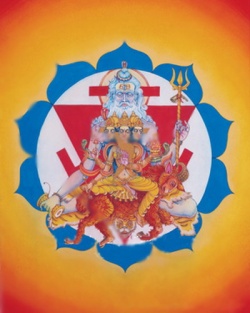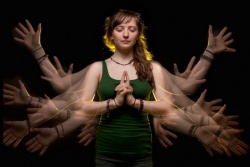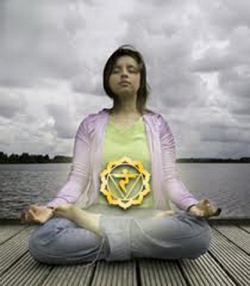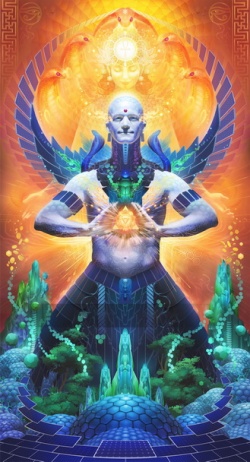Difference between revisions of "Manipura"
(Created page with "thumb|250px| <poem> '''Manipura''' (Sanskrit: मणिपूर, IAST: Maṇipūra), called "city of jewels", is the third primary chakra accordi...") |
|||
| Line 1: | Line 1: | ||
[[File:Manipura 01 300.jpg|thumb|250px|]] | [[File:Manipura 01 300.jpg|thumb|250px|]] | ||
<poem> | <poem> | ||
| − | '''Manipura''' (Sanskrit: मणिपूर, IAST: Maṇipūra), called "city of jewels", is the third primary chakra according to Hindu tradition. | + | '''[[Manipura]]''' ([[Sanskrit]]: मणिपूर, IAST: Maṇipūra), called "city of [[jewels]]", is the third primary [[chakra]] according to [[Hindu]] [[tradition]]. |
Location | Location | ||
| − | Located in the area of the solar plexus, navel, and the digestive system, the fiery third chakra is called Manipura, the "resplendent gem." Associated with the color yellow, this chakra is involved in self-esteem, warrior energy, and the power of transformation; it also governs digestion and metabolism. A healthy spirited third chakra helps overcome inertia and jump-starts a "get-up-and-go" attitude so it is easier to take risks, assert one's will, and assume responsibility for one's life. This chakra is also the location of deep belly laughter, warmth, ease, and the vitality received from performing selfless service.[1] | + | Located in the area of the {{Wiki|solar}} plexus, [[navel]], and the digestive system, the fiery third [[chakra]] is called [[Manipura]], the "resplendent [[gem]]." Associated with the {{Wiki|color}} yellow, this [[chakra]] is involved in [[self-esteem]], [[warrior]] [[energy]], and the power of [[transformation]]; it also governs {{Wiki|digestion}} and [[metabolism]]. A healthy spirited third [[chakra]] helps overcome {{Wiki|inertia}} and jump-starts a "get-up-and-go" [[attitude]] so it is easier to take risks, assert one's will, and assume {{Wiki|responsibility}} for one's [[life]]. This [[chakra]] is also the location of deep belly laughter, warmth, ease, and the [[vitality]] received from performing [[selfless]] service.[1] |
| − | Appearance | + | [[Appearance]] |
| − | Manipura is represented by a downward pointing red triangle, the fire region, within a bright yellow circle, with 10 dark-blue or black petals like heavily laden rain clouds. The triangle has a t-shaped swastika on each of its sides. The fire region is represented by the god Vahni, who is shining red, has four arms, holds a rosary and a spear, and is making the gestures of granting boons and dispelling fear. He is seated on a ram, the animal that represents this chakra. | + | [[Manipura]] is represented by a downward pointing red triangle, the [[fire]] region, within a bright yellow circle, with 10 dark-blue or black petals like heavily laden [[rain]] clouds. The triangle has a t-shaped [[swastika]] on each of its sides. The [[fire]] region is represented by the [[god]] Vahni, who is shining red, has four arms, holds a rosary and a spear, and is making the gestures of granting boons and dispelling {{Wiki|fear}}. He is seated on a ram, the [[animal]] that represents this [[chakra]]. |
| − | Seed Mantra | + | Seed [[Mantra]] |
[[File:Manipura-p4.jpg|thumb|250px|]] | [[File:Manipura-p4.jpg|thumb|250px|]] | ||
| − | The seed mantra is the syllable 'Ram'. Within the bindu or dot above this mantra resides the deity Rudra, who is red or white, with three eyes, of ancient aspect with a silver beard, and smeared with white ashes. He makes the gestures of granting boons and dispelling fear. He is either seated upon a tiger skin, or upon a bull. His Shakti is the goddess Lakini. She has a black or dark-blue vermillion color; three faces, each with three eyes; is four-armed; holds a thunderbolt, the arrow shot from the bow of Kama, fire; and makes the gesture of granting boons and dispelling fear. She is seated upon a red lotus. | + | The seed [[mantra]] is the {{Wiki|syllable}} 'Ram'. Within the [[bindu]] or dot above this [[mantra]] resides the [[deity]] [[Rudra]], who is red or white, with three [[eyes]], of {{Wiki|ancient}} aspect with a {{Wiki|silver}} beard, and smeared with white ashes. He makes the gestures of granting boons and dispelling {{Wiki|fear}}. He is either seated upon a [[tiger skin]], or upon a bull. His [[Shakti]] is the [[goddess]] [[Lakini]]. She has a black or dark-blue vermillion {{Wiki|color}}; three faces, each with three [[eyes]]; is four-armed; holds a [[thunderbolt]], the arrow shot from the [[bow]] of [[Kama]], [[fire]]; and makes the gesture of granting boons and dispelling {{Wiki|fear}}. She is seated upon a [[red lotus]]. |
Petals | Petals | ||
| − | The ten petals are dark-blue or black, like heavily laden rainclouds, with the syllables dda, ddha, nna, ta, tha, da, dha, na, pa, and pha upon them in a dark-blue colour. They correspond to the vrittis of spiritual ignorance, thirst, jealousy, treachery, shame, fear, disgust, delusion, foolishness and sadness. | + | The ten petals are dark-blue or black, like heavily laden rainclouds, with the {{Wiki|syllables}} dda, ddha, nna, ta, tha, da, dha, na, pa, and pha upon them in a dark-blue {{Wiki|colour}}. They correspond to the vrittis of [[spiritual]] [[ignorance]], [[thirst]], [[jealousy]], treachery, [[shame]], {{Wiki|fear}}, disgust, [[delusion]], [[foolishness]] and [[sadness]]. |
| − | Function | + | [[Function]] |
| − | Manipura is considered the center of dynamism, energy, will power and achievement (Itcha shakti), which radiates prana throughout the entire human body. It is associated with the power of fire and digestion, as well as with the sense of sight and the action of movement. Manipura is "the center of etheric-psychic intuition: a vague or non-specific, sensual sense of knowing; a vague sense of size, shape, and intent of being."[1] As such, some psychics recommend "listening" to it since it may help in making better decisions in one's life on many different levels.[2] | + | [[Manipura]] is considered the center of dynamism, [[energy]], will power and [[achievement]] (Itcha [[shakti]]), which radiates [[prana]] throughout the entire [[human body]]. It is associated with the power of [[fire]] and {{Wiki|digestion}}, as well as with the [[sense]] of [[sight]] and the [[action]] of {{Wiki|movement}}. [[Manipura]] is "the center of etheric-psychic {{Wiki|intuition}}: a vague or non-specific, {{Wiki|sensual}} [[sense]] of [[knowing]]; a vague [[sense]] of size, shape, and intent of being."[1] As such, some psychics recommend "listening" to it since it may help in making better decisions in one's [[life]] on many different levels.[2] |
[[File:Manipura-es.jpg|thumb|250px|]] | [[File:Manipura-es.jpg|thumb|250px|]] | ||
| − | Through meditating on Manipura, one is said to attain the siddhi, or occult power, to create, destroy or save the world. | + | Through [[meditating]] on [[Manipura]], one is said to attain the [[siddhi]], or [[occult]] power, to create, destroy or save the [[world]]. |
| − | Association with the body | + | Association with the [[body]] |
| − | The position of Manipura is stated as being either behind the navel or the solar plexus. Sometimes, when it is located at the navel, a secondary chakra called Surya (sun) chakra is located at the solar plexus, whose role is to absorb and assimilate prana from the sun. Being related to the sense of sight, it is associated with the eyes, and being associated with movement, it is associated with the feet. | + | The position of [[Manipura]] is stated as being either behind the [[navel]] or the {{Wiki|solar}} plexus. Sometimes, when it is located at the [[navel]], a secondary [[chakra]] called [[Surya]] ({{Wiki|sun}}) [[chakra]] is located at the {{Wiki|solar}} plexus, whose role is to absorb and assimilate [[prana]] from the {{Wiki|sun}}. Being related to the [[sense]] of [[sight]], it is associated with the [[eyes]], and being associated with {{Wiki|movement}}, it is associated with the feet. |
| − | In the endocrine system, Manipura is said to be associated with the pancreas and the outer adrenal glands; the adrenal cortex. These glands create important hormones involved in digestion, converting food into energy for the body, in the same way that Manipura radiates prana throughout the body. | + | In the endocrine system, [[Manipura]] is said to be associated with the pancreas and the outer adrenal glands; the adrenal cortex. These glands create important {{Wiki|hormones}} involved in {{Wiki|digestion}}, converting [[food]] into [[energy]] for the [[body]], in the same way that [[Manipura]] radiates [[prana]] throughout the [[body]]. |
Practices | Practices | ||
| − | In kundalini yoga, different practices for arousing and balancing the energies of Manipura include various asanas which work on that part of the body, pranayama, Uddiyana bandha (exhaling and pulling back and up the abdomen and diaphragm, respectively) and agnisara kriya (practicing jalandhara bandha, and moving the abdomen in and out), as well as the practice of nauli (stomach churning), and a pranayama called the union of prana and apana, where the lower and higher winds are made to unite together. | + | In [[kundalini]] [[yoga]], different practices for arousing and balancing the energies of [[Manipura]] include various [[asanas]] which work on that part of the [[body]], [[pranayama]], [[Uddiyana]] [[bandha]] (exhaling and pulling back and up the {{Wiki|abdomen}} and diaphragm, respectively) and agnisara [[kriya]] (practicing [[jalandhara]] [[bandha]], and moving the {{Wiki|abdomen}} in and out), as well as the practice of nauli ({{Wiki|stomach}} churning), and a [[pranayama]] called the union of [[prana]] and [[apana]], where the lower and higher [[winds]] are made to unite together. |
Comparisons with other systems | Comparisons with other systems | ||
[[File:Manipura-tag 01.jpg|thumb|250px|]] | [[File:Manipura-tag 01.jpg|thumb|250px|]] | ||
| − | In the Vajrayana Highest Tantra traditions, the navel wheel is extremely important as being the seat of the 'red drop'. It is triangular, red, with 64 petals or channels that extend upwards. Inside of it is the short syllable 'Ah'. Meditation on this syllable is the key component of the practice of Tummo, or inner heat, where the subtle winds are made to enter the central channel, and rise up to the top of the channel, in an experience akin to that of 'raising the kundalini' in Hindu terminology, melting the subtle white drop in the crown, and causing an experience of great bliss. This practice is considered the first and most important of the six yogas of Naropa.[3] | + | In the [[Vajrayana]] [[Highest]] [[Tantra]] [[traditions]], the [[navel]] [[wheel]] is extremely important as being the seat of the 'red drop'. It is triangular, red, with 64 petals or channels that extend upwards. Inside of it is the short {{Wiki|syllable}} '[[Ah]]'. [[Meditation]] on this {{Wiki|syllable}} is the key component of the practice of [[Tummo]], or [[inner heat]], where the [[subtle winds]] are made to enter the [[central channel]], and rise up to the top of the [[channel]], in an [[experience]] akin to that of 'raising the [[kundalini]]' in [[Hindu]] {{Wiki|terminology}}, melting the {{Wiki|subtle}} white drop in the {{Wiki|crown}}, and causing an [[experience]] of great [[bliss]]. This practice is considered the first and most important of the [[six yogas of Naropa]].[3] |
| − | In Chinese qigong, there exists three Dantians, acting as furnaces to convert different energies in the body. The lower Dantian exists in the region of the stomach. Its function is to convert sexual jing energy into Qi energy (a concept similar to Indian prana). | + | In {{Wiki|Chinese}} qigong, there [[exists]] three [[Dantians]], acting as furnaces to convert different energies in the [[body]]. The lower Dantian [[exists]] in the region of the {{Wiki|stomach}}. Its [[function]] is to convert {{Wiki|sexual}} jing [[energy]] into Qi [[energy]] (a {{Wiki|concept}} similar to [[Indian]] [[prana]]). |
| − | Within the system of the Sufi Lataif-e-sitta, there are a number of Lataif on the torso, but they are not distributed vertically, like chakras, but some are to the left and some to the right. The nafs, or lower self, is a centre situated below the navel. | + | Within the system of the [[Wikipedia:Sufism|Sufi]] Lataif-e-sitta, there are a number of Lataif on the torso, but they are not distributed vertically, like [[chakras]], but some are to the left and some to the right. The nafs, or lower [[self]], is a centre situated below the [[navel]]. |
| − | Western occultists make different kabbalistic associations with Manipura. For some, it relates to the sephira of Hod and Netzach, Netzach being that quality of energy to overcome different obstacles, and Hod being the tendency to control and break down energy into different forms, the two being contending and balancing forces, like the forces of anabolism and catabolism in the human body. Hod and Netzach are associated with the left and right legs and feet of the body.[4] | + | {{Wiki|Western}} [[occultists]] make different kabbalistic associations with [[Manipura]]. For some, it relates to the sephira of Hod and Netzach, Netzach being that quality of [[energy]] to overcome different {{Wiki|obstacles}}, and Hod being the tendency to control and break down [[energy]] into different [[forms]], the two being contending and balancing forces, like the forces of anabolism and catabolism in the [[human body]]. Hod and Netzach are associated with the left and right {{Wiki|legs}} and feet of the [[body]].[4] |
Alternative names | Alternative names | ||
| − | Tantra: Dashachchada, Dashadala Padma, Dashapatra, Dashapatrambuja, Manipura, Manipuraka, Nabhipadma, Nabhipankaja | + | [[Tantra]]: Dashachchada, Dashadala [[Padma]], Dashapatra, Dashapatrambuja, [[Manipura]], [[Manipuraka]], Nabhipadma, Nabhipankaja |
| − | Vedas (late Upanishads): Manipura, Manipuraka, Nabhi Chakra | + | [[Vedas]] (late [[Upanishads]]): [[Manipura]], [[Manipuraka]], [[Nabhi]] [[Chakra]] |
| − | Puranic: Manipura, Nabhi Chakra | + | {{Wiki|Puranic}}: [[Manipura]], [[Nabhi]] [[Chakra]] |
</poem> | </poem> | ||
{{W}} | {{W}} | ||
[[Category:Manipura]] | [[Category:Manipura]] | ||
Revision as of 08:05, 6 January 2014
Manipura (Sanskrit: मणिपूर, IAST: Maṇipūra), called "city of jewels", is the third primary chakra according to Hindu tradition.
Location
Located in the area of the solar plexus, navel, and the digestive system, the fiery third chakra is called Manipura, the "resplendent gem." Associated with the color yellow, this chakra is involved in self-esteem, warrior energy, and the power of transformation; it also governs digestion and metabolism. A healthy spirited third chakra helps overcome inertia and jump-starts a "get-up-and-go" attitude so it is easier to take risks, assert one's will, and assume responsibility for one's life. This chakra is also the location of deep belly laughter, warmth, ease, and the vitality received from performing selfless service.[1]
Appearance
Manipura is represented by a downward pointing red triangle, the fire region, within a bright yellow circle, with 10 dark-blue or black petals like heavily laden rain clouds. The triangle has a t-shaped swastika on each of its sides. The fire region is represented by the god Vahni, who is shining red, has four arms, holds a rosary and a spear, and is making the gestures of granting boons and dispelling fear. He is seated on a ram, the animal that represents this chakra.
Seed Mantra
The seed mantra is the syllable 'Ram'. Within the bindu or dot above this mantra resides the deity Rudra, who is red or white, with three eyes, of ancient aspect with a silver beard, and smeared with white ashes. He makes the gestures of granting boons and dispelling fear. He is either seated upon a tiger skin, or upon a bull. His Shakti is the goddess Lakini. She has a black or dark-blue vermillion color; three faces, each with three eyes; is four-armed; holds a thunderbolt, the arrow shot from the bow of Kama, fire; and makes the gesture of granting boons and dispelling fear. She is seated upon a red lotus.
Petals
The ten petals are dark-blue or black, like heavily laden rainclouds, with the syllables dda, ddha, nna, ta, tha, da, dha, na, pa, and pha upon them in a dark-blue colour. They correspond to the vrittis of spiritual ignorance, thirst, jealousy, treachery, shame, fear, disgust, delusion, foolishness and sadness.
Function
Manipura is considered the center of dynamism, energy, will power and achievement (Itcha shakti), which radiates prana throughout the entire human body. It is associated with the power of fire and digestion, as well as with the sense of sight and the action of movement. Manipura is "the center of etheric-psychic intuition: a vague or non-specific, sensual sense of knowing; a vague sense of size, shape, and intent of being."[1] As such, some psychics recommend "listening" to it since it may help in making better decisions in one's life on many different levels.[2]
Through meditating on Manipura, one is said to attain the siddhi, or occult power, to create, destroy or save the world.
Association with the body
The position of Manipura is stated as being either behind the navel or the solar plexus. Sometimes, when it is located at the navel, a secondary chakra called Surya (sun) chakra is located at the solar plexus, whose role is to absorb and assimilate prana from the sun. Being related to the sense of sight, it is associated with the eyes, and being associated with movement, it is associated with the feet.
In the endocrine system, Manipura is said to be associated with the pancreas and the outer adrenal glands; the adrenal cortex. These glands create important hormones involved in digestion, converting food into energy for the body, in the same way that Manipura radiates prana throughout the body.
Practices
In kundalini yoga, different practices for arousing and balancing the energies of Manipura include various asanas which work on that part of the body, pranayama, Uddiyana bandha (exhaling and pulling back and up the abdomen and diaphragm, respectively) and agnisara kriya (practicing jalandhara bandha, and moving the abdomen in and out), as well as the practice of nauli (stomach churning), and a pranayama called the union of prana and apana, where the lower and higher winds are made to unite together.
Comparisons with other systems
In the Vajrayana Highest Tantra traditions, the navel wheel is extremely important as being the seat of the 'red drop'. It is triangular, red, with 64 petals or channels that extend upwards. Inside of it is the short syllable 'Ah'. Meditation on this syllable is the key component of the practice of Tummo, or inner heat, where the subtle winds are made to enter the central channel, and rise up to the top of the channel, in an experience akin to that of 'raising the kundalini' in Hindu terminology, melting the subtle white drop in the crown, and causing an experience of great bliss. This practice is considered the first and most important of the six yogas of Naropa.[3]
In Chinese qigong, there exists three Dantians, acting as furnaces to convert different energies in the body. The lower Dantian exists in the region of the stomach. Its function is to convert sexual jing energy into Qi energy (a concept similar to Indian prana).
Within the system of the Sufi Lataif-e-sitta, there are a number of Lataif on the torso, but they are not distributed vertically, like chakras, but some are to the left and some to the right. The nafs, or lower self, is a centre situated below the navel.
Western occultists make different kabbalistic associations with Manipura. For some, it relates to the sephira of Hod and Netzach, Netzach being that quality of energy to overcome different obstacles, and Hod being the tendency to control and break down energy into different forms, the two being contending and balancing forces, like the forces of anabolism and catabolism in the human body. Hod and Netzach are associated with the left and right legs and feet of the body.[4]
Alternative names
Tantra: Dashachchada, Dashadala Padma, Dashapatra, Dashapatrambuja, Manipura, Manipuraka, Nabhipadma, Nabhipankaja
Vedas (late Upanishads): Manipura, Manipuraka, Nabhi Chakra
Puranic: Manipura, Nabhi Chakra



